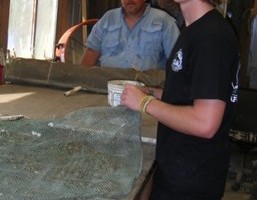Jake Massey loped toward the boat. His white boots did not quite mesh with the red “I’ve got tiger blood,” t-shirt. His long, perpetually-in-his-eyes hair beneath a red trucker hat is decorated with sharpie marker eyeballs. Jake is a 17-year-old senior at Wando High School, and except for the white boots, he looks like any other high school senior. Of the 3,265 Wando students beginning next year, he is the only student clam farmer, with a unique opportunity to pay for college tuition and maybe even a surfing trip to Costa Rica.
How does a Charleston high school student become a clam farmer?
Jake is the fourth generation in his family to earn a living in South Carolina waters. This part-time job was bestowed upon him by the family seafood business, Livingston’s Bulls Bay Seafood, and the mother of all – necessity. Jake will graduate in May 2012 with a special emphasis in surfing and skateboarding. With the ever-increasing cost of college, and a good but not superstar academic record, the Massey family decided that he needed to plant his own clams to help pay for college costs in just over a year.
The idea started germinating several years ago when a representative from the U.S. Food and Drug Administration’s Farm Service Agency told Jake’s parents about the Rural Youth loans* that were available to their children as clam farmers. Aquaculture is regulated under the FDA and their program will loan up to $5,000 to rural youths age 10 through 20 to purchase seed and other necessities to begin farming. Although the family decided to pay for the initial investment themselves, they liked the idea of Jake planting his own clams and are banking on their sweat equity investment as a way to pay for college.
How do you plant clams?
Jake’s father, Jeff Massey, planted the tiny clam seed back in October
wearing a wet suit to protect him from the cold water. He purchased the seed from another South Carolina clam farmer who operates a hatchery where he spawns and grows the seed to about four to six millimeters in thickness. During the first stage of planting these clam seed, Jeff placed about 10,000 in small-mesh four-foot square nursery bags. He connected these bags to one another with tie-wraps and rolled them along the muddy bottom (much like laying sod) of aquaculture leases where they remained for four months and grew to be about nickel-sized.
When it was time to transfer the seed to grow out bags, the weather was warm, and the whole family was able to bring in the seed clams to the dock where they washed, measured and transferred them to grow out bags timing their boat rides to the aquaculture lease with the tides and the corresponding water level they needed. On this day, they were able to bring in the seed by mid-morning and take a lunch break before planting in grow out bags.
After lunch, the family, Mom Kim, Jeff, Jake, and his 12-year-old sister Katie loaded the boat and motored 20 minutes away to their aquaculture lease in Cape Romain Wildlife Refuge. The work was muddy and hot and the horse flies were merciless, but the whole family had a taste of Dad Jeff’s days spent harvesting clams. At 9:00 p.m., when they finally motored back in, they were sun burnt, salt-encrusted and sore.
They will wait about eleven months to harvest these clams and plan to begin harvesting in May of 2012. If all of these seed grow to maturity, the clams could sell for about $10,000, and earning this will require many more harvesting trips. Jake will also need to reinvest at least $1,000 to pay for the following years’ seed, since college tuition will be due again. One hungry sea turtle or a few clam-hungry sting rays could wreck Jake’s best-laid plans.
Now What?
Like many 17 year-olds, Jake doesn’t know where he’d like to go to college or what he’ll study. He is pretty sure he doesn’t want to be a clam farmer, but so were his parents twenty years ago. The clam farming profits will be there when he decides where to go after graduation. Until he decides, Kim and Jeff Massey are pleased that both of their children are learning about hard work, the value of planning and taking advantages of the unique opportunities they have. Jake and Katie are learning that brains and college plans go well with marsh mud, sweat and even horse flies.
*United States USDA Farm Service Agency. Rural Youth Loans. , 2004. Print.
